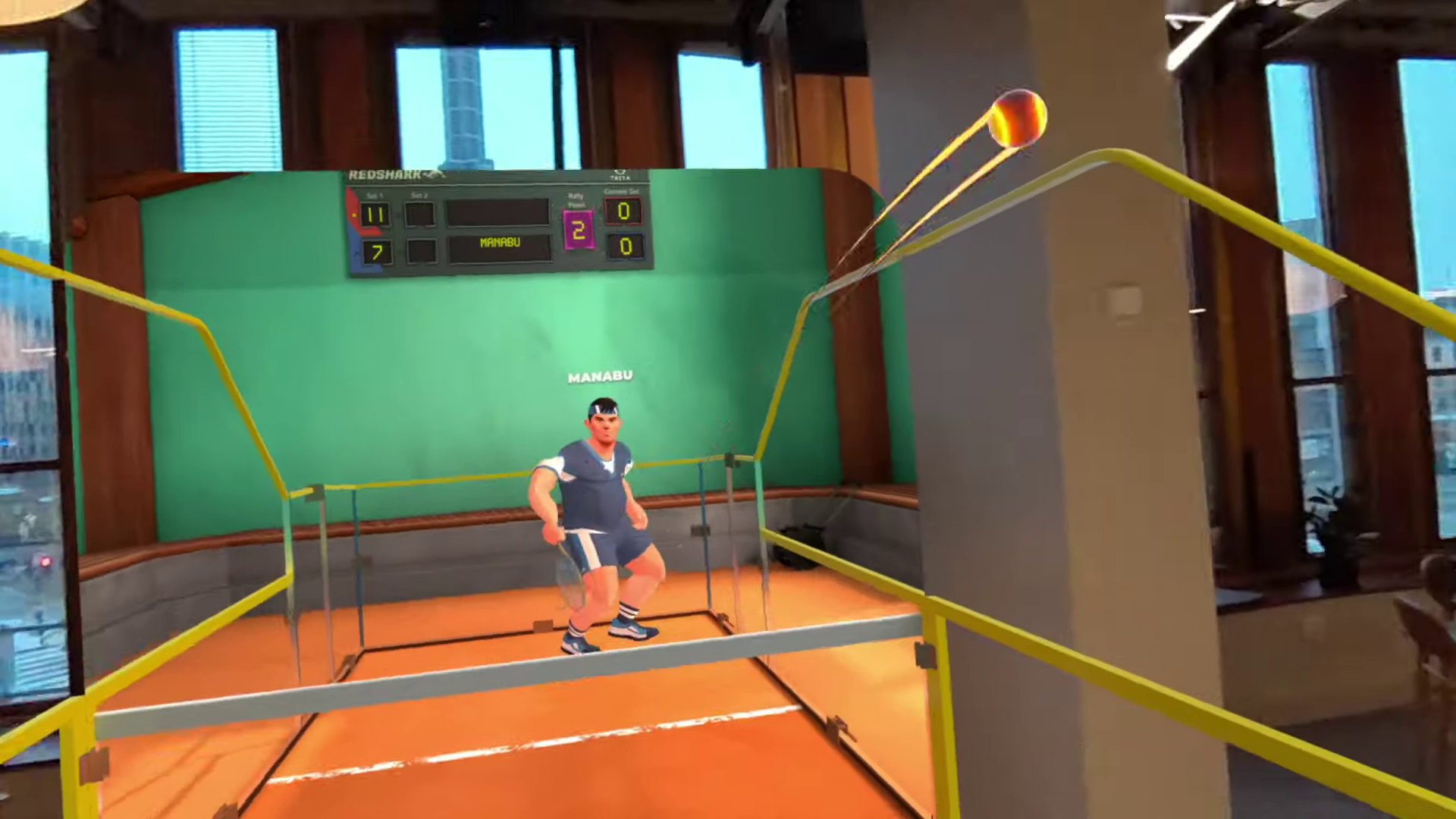SHOWCASE INDEX
GAME SUMMARY
What is Racket Club?
THE CHALLENGE
Difficulties with Mixed Reality
THE SOLUTION
How did we approach and complete this project?
THE RESULT
Watch the final result and behind the scenes video
GAME SUMMARY
Welcome to Racket Club - where the exhilarating world of racket sports meets the immersive realm of virtual reality! Get ready to step into the most dynamic, adrenaline-pumping fusion of tennis, pickleball, padel, and ping-pong ever created.
Whether you're a solo player seeking the glory of Career Mode or craving the thrill of multiplayer showdowns in singles or doubles, Racket Club promises an electrifying experience. Feel the rush as each rally challenges you to keep the ball in play, racking up points and testing your skills against opponents.
Brace yourself for a VR game that mirrors the real movement and physics of racket sports, providing an unparalleled level of authenticity. Your every swing, lob, and smash will feel as true-to-life as if you were on an actual court.
But it's not just about the game—it's about the community. Meet fellow enthusiasts, forge new partnerships, and rekindle old rivalries both on and off the court. Spectate alongside friends, form doubles teams, or compete fiercely in singles matches for the ultimate bragging rights.
And when you're ready to train or warm up, face off against AI bots that challenge you at every skill level. Sharpen your abilities and prepare to conquer even the highest echelons of competitive play.
Racket Club isn't just a game; it's a gateway to a world where the thrill of racket sports meets the immersive power of VR. Get ready to serve, smash, and volley your way to victory!
THE CHALLENGE
Resolution Games tasked Dextry with creating a captivating shot specifically for the launch trailer of Racket Club. The goal was to create an end shot that would show off the mixed reality feature of the game.
A general challenge for the XR market is how to show off an app or game that utilizes mixed reality. Whether it is a game trailer, internal presentation or app feature showcase - the approach to producing the content usually ends up in either of these two categories: Cheap, but low quality - or high quality, but expensive.
Method A: Low Quality + Economical
This method - while cost-effective - involves capturing directly from vendor HMDs, but it comes with significant drawbacks. The primary issue stems from the camera system within these HMDs, which, despite improvements in newer generations, falls short of standard production cameras in several aspects. Firstly, the HMDs' camera systems severely limit shot flexibility, eliminating possibilities for handheld or steadicam shots. Moreover, lacking manual controls for settings like aperture and ISO, these systems curtail precise adjustments for exposure. With resolutions capped at 1080p despite the potential for 3400 x 3400, the HMD cameras lag significantly behind standard production cameras recording in 4k to 8k, impacting creative freedom by limiting cropping and zooming capabilities. Additionally, the absence of lens variability restricts creative control over framing and depth of field. Minimal dynamic range in the sensors increases the risk of overexposed or underexposed areas, affecting overall image quality and complicating lighting setup. Furthermore, capturing in heavily compressed formats with limited bitrates, as opposed to RAW recording, causes color depth loss, making color grading nearly impossible and leading to potential issues like compression artifacts and color banding.
Method A and Post-Production
Illustrating the lack of separation on HMD capture; there is no way to have live action and app/game elements as different layers
This method, leveraging traditional cameras for high-quality real-world/live action recordings while separately capturing game elements, introduces significant complexities. The process involves filming the real world first, followed by integrating app/game elements during editing, resembling a conventional production approach. However, the primary challenge arises from the need to replicate game elements to match their appearance during filming, a task demanding meticulous recreation of game logic, animations, and shaders.
This replication process, often done outside the game engine, causes hurdles - especially concerning unique shaders or complex particle systems. These become challenging to replicate accurately within software like Maya or Blender due to technical differences between real-time graphics and off-line rendering. Even if possible, they can take considerable time to replicate. Consequently, the final outcome might not faithfully represent the original app/game or may overlook showcasing certain game features due to the time-intensive replication process.
Moreover, each shot demands 3D tracking to seamlessly merge game elements with live-action footage, escalating production costs significantly. The absence of real-time action preview during filming further complicates effective shot planning and execution.
In essence, while using traditional cameras for high-quality real-world/live action recordings ensures top-notch visuals, the complexities in replicating and integrating game elements alongside managing production costs highlight the limitations in seamlessly blending digital and real-world/live action elements within the final product.
Person on the left acts as camera man using the HMD to record the person on the right
POV from HMD. The speed effect and the shader of the ball can take considerable time to replicate for post production
The in-game hand might not look the best for presentation purposes. Also, notice the distortion around the real hand/arm
Method A coupled with post-production poses challenges due to the integration of in-app/game elements within the real-world/live action footage captured by HMDs. The inability to disentangle these elements from the footage severely limits post-production possibilities. One major hurdle is the lack of separation between the raw footage and the embedded in-app/game elements, making fundamental tasks like color grading impractical. Adjusting colors or contrasts for the real-world/live action independently becomes cumbersome with these integrated elements.
Furthermore, the limitations extend to post-production techniques chroma keying (green screen). The merged in-app/game elements obstruct the effective use of green screens, hindering background replacement or the integration of digital elements seamlessly. This issue highlights the importance of a camera system that allows for the isolation of real-world/live action from in-app/game elements - enabling various post-production enhancements. Separating these elements would open doors to refining colors, creating CG environments, and unlocking a spectrum of creative possibilities that significantly enhance the final quality and artistic expression of the content.
Method B: High-Quality + Cost-Intensive
THE SOLUTION
Illustration: Dextry Studios System
Illustration: Racket Club Concept
Dextry Studios Method
Before taking on a project we do a technical evaluation of the app/game first. Since every project is different and can vary widely in how they are set up - this assessment serves as a checklist to identify any additional work that might be required before we move on to implementing our system. The project is diverged into a separate branch specifically for the production.
1. System Integration
We implement our Dextry Spectator Toolset turning the Cyclops into a spectator camera inside the Unity project.
For Racket Club, it was almost plug and play.
2. Custom Solutions
Any additional custom code or other solutions are implemented if needed. This could be specific features of the app/game that needs extra code in order to work properly with the system - or it could be adding visual features like depth of field for heightening the aesthetic/storytelling aspect of the production.
For Racket Club, the client preferred to avoid any visual enhancements in order to accurately display the actual graphics. However, it was decided to add motion blur as the result would let the game elements blend more naturally with the live action footage.
Highlights
Cinematic Effects (DOF, motion blur etc.)
3. Previz
All shots are previsualized, adjusted and iterated on for the Cyclops, added to the edit and eventually signed off by the client.
For Racket Club, there was only a single shot. We created an engaging camera move showing the game close up, moving backwards into the real world. The camera move was iterated on for a few versions until the client signed it off.
Highlights
1:1 Previz (camera move will be identical to final shot)
Camera Control (Camera can be controlled in a variety of methods such as via the Cyclops, shoulder rig or game controller)
4. Shoot
Shooting is done in the studio based on the previous steps using all the tools that our system offers. This ensures a smooth and enjoyable shoot.
For Racket Club, it was essential to see the gameplay live in order to properly do timings and the action.
Highlights
Live Preview (all elements composited together in real-time)
App/Game Runtime
App/Game Recording
Instant Proxies
5. Shot Selection
Choosing shots can be done immediately after the shoot using the automated proxies produced by our pipeline.
For Racket Club, we did the initial selection based on timing of the action and how the talent was moving. This selection was narrowed down to 6 shots and then presented to the client who selected the final shot.
Highlights
Precomped Proxies
6. Post Production
If post production is done by a 3rd party, we deliver all material and data organized and conformed via our pipeline for immediate engagement upon delivery.
In the case of Racket Club, we did the post production inhouse.
Highlights
3D Camera (no tracking required)
Truncated Material (all elements are aligned)
7. Delivery
The production is wrapped up and delivered.
Highlights
Happy client
Having done previous mixed reality shots similar to the one tasked here - we knew that using our tried and trusted system would make the project straightforward to complete.
With our system we are able to transform the Cyclops motion control into the most advanced and elegant spectator camera inside Unity. In conjunction with our entire system - we are able to tackle the diverse technical challenges mentioned earlier, while also delivering outstanding cost efficiency.



































